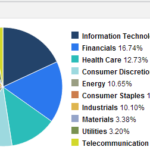The great rotation was anything but great. Data reflects only modest differences in fund flow data, but where the funds are flowing, there’s serious concentration. The PowerShares Dynamic Food & Beverage ETF (PBJ) suggests that investors who want a lower risk profile are turning to consumer staples equities.
The fund tracks 30 different food and beverage companies in the United States, and so far this year, it’s crushed the broader S&P 500 SPY with returns of 32.65%.

An impressive rise puts the fund in line with earnings multiples of the broader market. PBJ holdings trade at a price-earnings ratio of 18.2 vs. 19.5 for the S&P 500. Given its exposure to consumer staples, earnings growth is hardly in line with what you would expect for the bottom line of your average S&P 500 component.
High valuations with headwinds
Yield investors seem to have taken to stocks to get away from falling bond prices. I think that’s especially true in consumer staples, which are trading at multiples for perfection.
Let’s not forget that several factors that worked to the advantage of food and beverage stocks in recent years. First, a weak dollar helped with currency translation. A weak dollar is a plus for American firms which generate substantial earnings outside the United States. Many of the companies in the food and beverage industry generate more money from outside American borders. As higher rates look more and more likely, the US dollar has recovered as capital flows back to yield in the US.
Secondly, recency bias is biting your conservative investor. Look back to 2009 and it was the consumer staples that were an island of profitability in a sea of red. Those who remember the volatility of the financial crisis embrace the stability of defensive stocks in a recession.
Some micro factors are also at play. Defensive names have been the most aggressive acquirers of their own stock, helping drive share prices higher.
Compelling as a bond alternative
The food and beverage ETF is fairly compelling if your investment alternative is of the fixed-income variety (see more on compelling fixed income ETFs). If we suppose that food and beverage names can increase the top line at the rate of GDP growth and generate somewhat higher bottom line growth, the industry should post long-term returns at or near the S&P 500 with less volatility. Investors would have to be comfortable buying the industry at prices 32% higher than on January 1.
The ETF’s real asset is the durability of the average company in the portfolio. It holds companies with entrenched competitive positions including stalwarts like General Mills, Kellogg, and PepsiCo.
Over the long haul, one would expect some consolidation in the industry. Food and beverage companies enjoy substantial distribution synergies from an acquisition. Private-equity deals are especially alluring. Berkshire Hathaway’s leveraged buyout of Heinz will spew predictable cash flows for years, with upside in restructuring.
As a play on the consumer staples, it is certainly one of the best. An alternative ETF, the Consumer Staples Select Sector SPDR (XLP) tracks large cap stocks in a broader consumer staples category. PBJ’s allocation to smaller stocks should lead it to better long-term performance on the back of mergers and acquisitions. It’s likely that the holdings in XLP will be future acquirers of companies in PBJ.
It’s unlikely that food and beverage stocks will be the next multi-bagger, but for investors who want exposure to equity with less volatility can take a bite out of the PBJ ETF. At 19x earnings, the average constituent isn’t particularly cheap, but not necessarily expensive, either. This ETF is perfect as part of a buy and hold portfolio.
Disclosure: No position in any tickers mentioned here.










{ 0 comments… add one now }